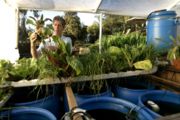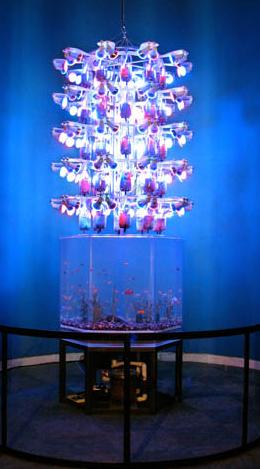Difference between revisions of "Food/Aquaponics"
(Added mention of Growing Power) |
|||
| (12 intermediate revisions by the same user not shown) | |||
| Line 1: | Line 1: | ||
[[Image:Aquaponics.jpg|right|180px]] | [[Image:Aquaponics.jpg|right|180px]] | ||
| − | |||
| − | + | Hydroponics is growing plants in water. Aquaculture is growing fish in tanks. The disadvantage of hydroponics is the constant input of mineral nutrients it needs. The disadvantage of aquaculture is the difficulty of keeping the water clean. Aquaponics combine the two systems and thereby cancels out the weaknesses of both. | |
| − | + | In aquaponics, edible fish are grown in a tank. The fish eat the algae that will grow naturally in nearly any still body of water, or pond weeds can be grown. (Most aquaponic systems now use fish food, but methods under development eliminate the need for this input by cultivating [http://www.p2pays.org/ref/09/08875.htm duckweed] or algae.) The fish effluent enriches the water with nutrients. This water then serves as the medium to grow hydroponic herbs and vegetables. The roots of the herbs and vegetables, and the bacteria that grow around them, clean the water for the fish. Both the fish and the plants can be eaten by humans. | |
| + | |||
| + | Some aquaponics systems also include a wormery, which uses the inedible parts of the plants to feed worms. The worms are then fed to the fish and the compost they produce can be used to nourish more plants, or made into compost tea to add more nutrients to the hydroponic system. This brings the system closer to a fully closed-loop that recycles all its waste. | ||
| + | |||
| + | It should be apparent from this description that aquaponics is an extremely resource-efficient method of food production. No fertilizers are needed and there is no pollution. It is really the only [[Survival of our species/Long-term thinking|sustainable]] way of producing fish; much more sustainable than conventional fish-farming and certainly more sustainable than current fishing practices. In theory an aquaponic system could be run without external input (though in practice fish food and calcium and other minerals often need to be supplied.) Aquaponics requires 10% the [[Fundamental resources/Water|water]] of growing vegetables in soil, because the water is constantly recycled rather than draining away. This means that aquaponic farms nearly anywhere in the world can run on rainwater alone. | ||
| + | |||
| + | Aquaponics is extremely productive. The plant yields compare favorably with hydroponics, and are much higher than growing in soil. Some research even points to the possibility of achieving much higher yields with aquaponics than even with hydroponics<sup>[http://www.greenhousecanada.com/content/view/965/67/]</sup>. | ||
| + | The aquaponics system at the University of the Virgin Islands<sup>[http://ag.arizona.edu/azaqua/ista/ista6/ista6web/pdf/676.pdf]</sup> grows over 4000kg of tilapia and over 2500kg of okra yearly. This is more than enough fish for 35 people and more than enough vegetables for four people and it is all grown on just 500m<sup>2</sup> of space. And this system does not even use space optimally; the 500m<sup>2</sup> figure includes the gaps between the tanks. Improvements on the University of the Virgin Islands system have since been made <sup>[http://www.greenhousecanada.com/content/view/965/38/][http://www.growshop.com/hydroponic-systems/aeroponics/aquaponics-revisited.html]</sup>. [http://growingpower.org Growing Power] is an urban farm in Milwaukee. It uses several methods of growing, but aquaponics is the main one. On a footprint of just three acres (12,150m<sup>2</sup>), they grow enough food for 10,000 people<sup>[http://www.growingpower.org/Press%20kit%205-20.pdf]</sup>. | ||
| + | |||
| + | Over the next few years, as a result of the research that is being done, aquaponic systems will become even more productive, more automated and require less input than current ones. This will make aquaponics even more appealing than it is now. | ||
| + | |||
| + | ---- | ||
| + | <div style="text-align: center; direction: ltr; margin-left: 1em;"><p>[[Image:Farmfountain.jpg]]</p><p> [http://farmfountain.com/ Farm Fountain] is 'a sculptural ecosystem you can eat'. It shows how aquaponics can be applied as a vertical farming method. The design, by Ken Rinaldo and Amy Youngs, is available under a [[Open collaborative design|Creative Commons license]] and their website gives instructions on [http://farmfountain.com/howto/index.html how to build your own]. The fish tank at the bottom produces edible fish and effluent-enriched water, which is circulated among the bottles above, where plants are grown hydroponically.</p></div> | ||
Latest revision as of 00:27, 17 March 2012
Hydroponics is growing plants in water. Aquaculture is growing fish in tanks. The disadvantage of hydroponics is the constant input of mineral nutrients it needs. The disadvantage of aquaculture is the difficulty of keeping the water clean. Aquaponics combine the two systems and thereby cancels out the weaknesses of both.
In aquaponics, edible fish are grown in a tank. The fish eat the algae that will grow naturally in nearly any still body of water, or pond weeds can be grown. (Most aquaponic systems now use fish food, but methods under development eliminate the need for this input by cultivating duckweed or algae.) The fish effluent enriches the water with nutrients. This water then serves as the medium to grow hydroponic herbs and vegetables. The roots of the herbs and vegetables, and the bacteria that grow around them, clean the water for the fish. Both the fish and the plants can be eaten by humans.
Some aquaponics systems also include a wormery, which uses the inedible parts of the plants to feed worms. The worms are then fed to the fish and the compost they produce can be used to nourish more plants, or made into compost tea to add more nutrients to the hydroponic system. This brings the system closer to a fully closed-loop that recycles all its waste.
It should be apparent from this description that aquaponics is an extremely resource-efficient method of food production. No fertilizers are needed and there is no pollution. It is really the only sustainable way of producing fish; much more sustainable than conventional fish-farming and certainly more sustainable than current fishing practices. In theory an aquaponic system could be run without external input (though in practice fish food and calcium and other minerals often need to be supplied.) Aquaponics requires 10% the water of growing vegetables in soil, because the water is constantly recycled rather than draining away. This means that aquaponic farms nearly anywhere in the world can run on rainwater alone.
Aquaponics is extremely productive. The plant yields compare favorably with hydroponics, and are much higher than growing in soil. Some research even points to the possibility of achieving much higher yields with aquaponics than even with hydroponics[1]. The aquaponics system at the University of the Virgin Islands[2] grows over 4000kg of tilapia and over 2500kg of okra yearly. This is more than enough fish for 35 people and more than enough vegetables for four people and it is all grown on just 500m2 of space. And this system does not even use space optimally; the 500m2 figure includes the gaps between the tanks. Improvements on the University of the Virgin Islands system have since been made [3][4]. Growing Power is an urban farm in Milwaukee. It uses several methods of growing, but aquaponics is the main one. On a footprint of just three acres (12,150m2), they grow enough food for 10,000 people[5].
Over the next few years, as a result of the research that is being done, aquaponic systems will become even more productive, more automated and require less input than current ones. This will make aquaponics even more appealing than it is now.
Farm Fountain is 'a sculptural ecosystem you can eat'. It shows how aquaponics can be applied as a vertical farming method. The design, by Ken Rinaldo and Amy Youngs, is available under a Creative Commons license and their website gives instructions on how to build your own. The fish tank at the bottom produces edible fish and effluent-enriched water, which is circulated among the bottles above, where plants are grown hydroponically.

